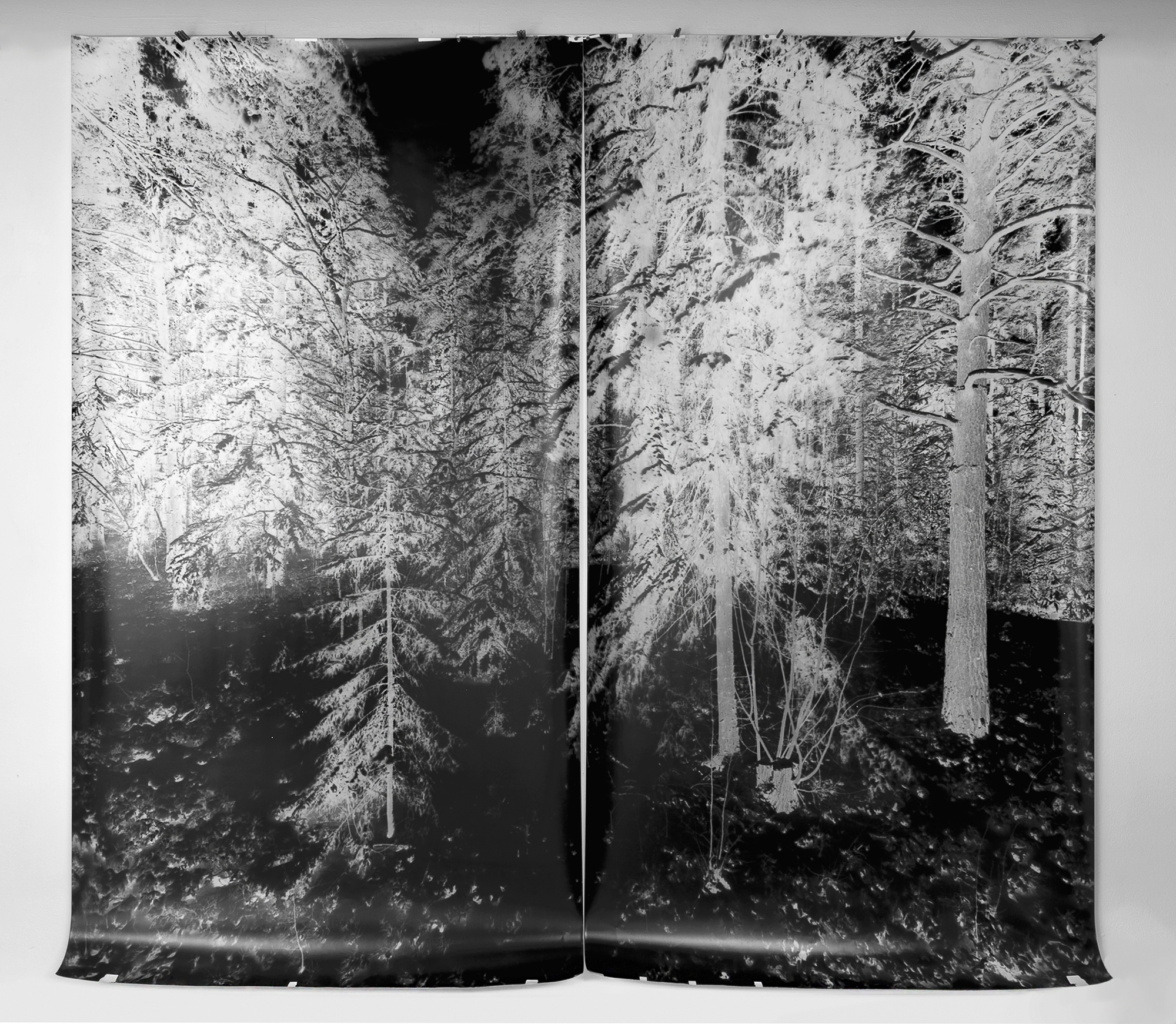v

Kristian Jalava: Käänteinen maailma
2.4.–2.5.2022
FI
Käänteinen maailma -valokuvaprojektissa Kristian Jalava pimentää erilaisia rakennuksia neulanreikäkameroiksi ja valottaa suurikokoisia negatiivikuvia suoraan mustavalkopaperille. Kokeellisessa valokuvamenetelmässä Jalava hyödyntää yhteiskunnan staattisia rakenteita osana kuvan tekemisen prosessia. Jalava tarkastelee muuttuvan maailman ilmiöitä rakennusten näkökulmasta – hidasta aikaa ylläpitävien rakenteiden suojasta.
Rakennuksen mittakaavassa valokuvaamisesta tulee hidas ja kehollinen tapahtuma. Pimeässä huoneessa (lat. camera obscura) syntyvä optinen kuva on suorassa – ja käänteisessä – suhteessa rakennusta ympäröivään maisemaan. Pitkän valotuksen aikana ulkomaailman objekteista heijastuvat auringonsäteet piirtävät valoherkälle pinnalle latentin (piilevän) kuvan, joka kehittyy fotokemiallisessa prosessissa negatiivikuvaksi. Voidaan ajatella, että jäljen tasolla negatiivinen valokuva on lähempänä fysikaalista todellisuutta kuin toisasteisia valotuksia vaativa positiivikuva.
Negatiivinen valokuva on monitulkintainen ja sen merkitys vaihtelee kuvauskohteesta riippuen. Käänteisyys voidaan nähdä normatiivisen ajattelun ja sosiaalisen kontrollin vastavoimana, tai ekologisen jälleenrakentamisen aikakaudella tapahtuvana ympäristöajattelun muutoksena. Ajankohtaisia lukutapoja käänteisyyden tematiikalle antavat arkitodellisuuttamme sävyttävä koronapandemia ja Euroopassa syttynyt sota. Epävarmana aikana yleinen kysymys kuuluu, että milloin – jos koskaan – voidaan palata normaaliin arkeen. Millainen on uusi normaali? Negatiivinen kuva maailmasta ilmentää sellaista outouden ja vierauden tunnetta, joka vallitsee tavallisesta poikkeavana aikana tutussakin ympäristössä. Käänteisessä maailmassa erilaiset uhkakuvat tulevat osaksi ihmisten jokapäiväistä elämää.
Käänteinen maailma -sarjan teokset on kuvattu Turussa ja Helsingissä, sekä Örön, Utön ja Korppoon saarilla. Kameroina projektissa ovat toimineet mm. bunkkerit, kirkko, baari, rakennustyömaa, entinen synnytyslaitos ja tupakkatehdas. Paikkojen monitahoisesta sommitelmasta löytyy erilaisia tila-ajallisia merkityksiä; rakennusten siirtymävaiheet, paikallisuus, purku-uhka, syntymähuone, katoava maisema, koronasulku ja käänteinen raunio.
Valokuvakeskus Nykyajassa Kristian Jalava esittää Käänteinen maailma -projektin teoksia ensimmäistä kertaa yksityisnäyttelyn muodossa. Esillä on viisi teosta: New moon (2022) valotettu Taiteilijatalo Fimbulissa, Turussa. Skylight II (2021), Taideyliopiston uudisrakennuksessa, Helsingissä. Vital landscape (2021), armeijasaaren bunkkerissa, Utössä. Birth (2019), Heidekenin entisessä synnytyslaitoksessa, Turussa. Potentials (2018), Oksasenkatu 11 -galleriassa, Helsingissä.
//
EN
Invertible World
In the photography project Invertible World, Kristian Jalava darkens various buildings into pinhole cameras and exposes large negative images directly on black and white paper. With his experimental photographic method, Jalava utilizes the static structures of society as part of the analogue image-making process. Jalava looks at the phenomena of a changing world from the perspective of buildings – in a shelter of structures that maintains slow time.
On a scale of a building, photographic work becomes a slow and bodily event. The optical image created in a dark room (camera obscura) is in direct – and inverse – relation to the landscape around the building. During long exposure, the sun’s rays reflected from objects in the outside world draw a latent image on the photosensitive surface, which is then developed into a negative image in the photochemical process. At the level of the index, a negative photograph is closer to physical reality than a positive image requiring secondary exposures.
A negative photograph is ambiguous and its meaning varies depending on the subject. The inverse can be seen as a counterweight to normative thinking and social control, or as a change in environmental paradigm in an era of ecological reconstruction. Current readings on the theme of inversion are provided by the corona pandemic that tones our everyday reality and also the war that broke out in Europe. In times of uncertainty, the common question is when – if ever – can we return to a normal life. What is the new normal like? The negative image of the world expresses the kind of uncanniness and alienation that prevails in an unusual time, even in a familiar environment. In the invertible world, different threats become part of people’s daily lives.
All the sites of the Inverted World series are located in Southern Finland, in Turku and Helsinki, as well as on the islands of Örö, Utö and Korppoo. Bunker, church, bar, construction site, former maternity hospital and tobacco factory, among others, have become photographic cameras in the project. There are various spatial-temporal meanings to be found in the complex composition of these places: transitions, locality, threat of demolition, birth, vanished landscape, corona closure, reversed ruin.
In Photographic Center Nykyaika Kristian Jalava presents the works of the Inverted World project for the first time in the form of a solo exhibition. On display are five works: New moon (2022) is exposed in the Fimbul artists studio space, Turku. Skylight II (2021), in the new building of the University of the Arts, Helsinki. Vital landscape (2021), in the bunker of Utö Island. Birth (2019), in the former maternity hospital Heideken, Turku. Potentials (2018), at Oksasenkatu 11 Gallery, Helsinki.